Environmental concerns at Windermere are again making local and national headlines, generating significant attention around sewage pollution and the seasonal fluctuations of cyanobacteria (blue-green algae).
I recognise this attention has created further adaptation, ambivalence, and avoidance within the swim communities, so I thought it may be useful to offer a snippet of my reflections explored (so far) during my current PhD fieldwork.
Note: I recorded this footage at Rayrigg Meadow in August 2022, a month before the fieldwork commenced.
Last summer, Windermere encountered significant algal blooms, particularly in the North Basin following a spell of intensely dry and warm weather [1]. Parts of Windermere became visually comparable to a thick pea soup, while other parts experienced slicks and scums, slimy rocks, and a flurry of green dandruff-like flakes, complicating the motivations of some swimmers, dippers, and other users.
Now that we are in July, I have noticed these flakes forming again in the dark waters at Rayrigg Meadow and Millerground when submerging my head. There have been reports of slicks and scums at other parts of Windermere too across the year [2].
It’s important to note that cyanobacteria put its towel down on our global sun lounger long before the arrival of humans, approximately three-billion years ago. At Windermere, cyanobacteria formed over 14,000 years ago following the lakes glacial formation and appeared to increase during the rise of tourism, particularly from 1860 onwards, 13 years after the railway opened [3].
Other species of bacteria are present [4], nevertheless cyanobacteria growth rates can increase under rising temperature, light, and nutrient levels (typically phosphorus and nitrogen), sometimes contributed by sources of wastewater and agricultural run-off [5].
Dry and calm weather can lead to cyanobacteria rising to the surface and can be pushed towards the shores and bays by the wind, however, not all algal blooms are toxic or evenly concentrated, and their impact can be transient [6].
A casual gaze across the water arguably cannot determine its potential impact, as it requires sampling and testing in controlled laboratory conditions to verify its toxicity [7]. Equally, claiming that Windermere is risk-free is also contentious. Algal blooms can carry potential health concerns for those coming into direct contact, including skin rashes, eye irritation, vomiting and diarrhoea, fevers and pains in muscles and joints for humans, while also sometimes fatal to dogs, livestock, birdlife, and fish [8] [9] [10].
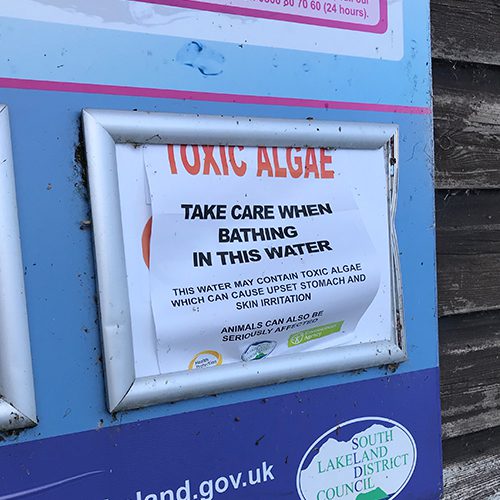
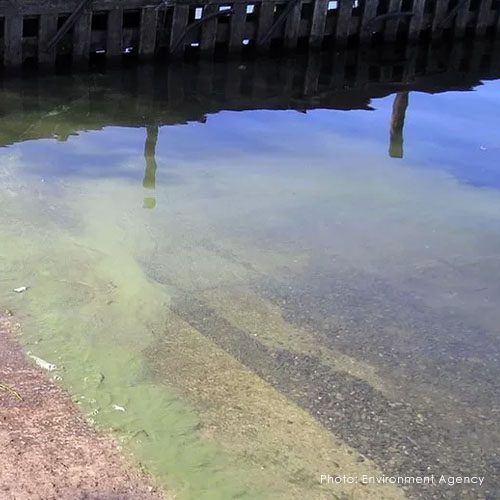
A small number of swimmers I have interviewed (so far) have reported sickness following direct contact with algal blooms while swimming. One swimmer suggested swimming in Windermere led to rashes on their palms. This rash appeared unrelated to the symptoms of ‘swimmers itch’ (cercarial dermatitis), a mild allergic skin reaction to a parasite of the family Schistosomatidae, sometimes present in freshwater waterfowl [11].
The majority of swimmers I have spoken to have decisively reported having experienced no symptoms when reflecting on their practices at Windermere, yet some have mentioned other waters where they have encountered illness.
Exposure, alongside other bodily states/stresses may also complicate these experiences, particularly by those exerting themselves during long distance swimming. Interestingly, one long-distance swimmer I interviewed anticipated ‘getting sick’ when reflecting on their goal of swimming the length of Windermere this summer yet suggested that their ambitions outweighed the health concerns.
The ‘official’ bathing season (May – September) [12] typically encounters more long-distance swimming, including competitive events. Although, during my observations, most recreational users dip or stay close to the shores. Unfortunately, it’s typically during the later summer seasons that cyanobacteria’s growth rate is higher, plus climate change continues to complicate the timing of this period [13].
Interestingly, these concerns about blue-green algae and sewage seemingly drown out other environmental challenges, including flooding, plastic pollution, and biosecurity. Reducing the spread of invasive species between freshwater sites, encouraged by the ‘Check, Clean, Dry’ campaign [14], is often entrenched by paddling, angling, triathlon, and established swim groups, yet I sense these messages are largely unrecognised by visitors and newcomers.
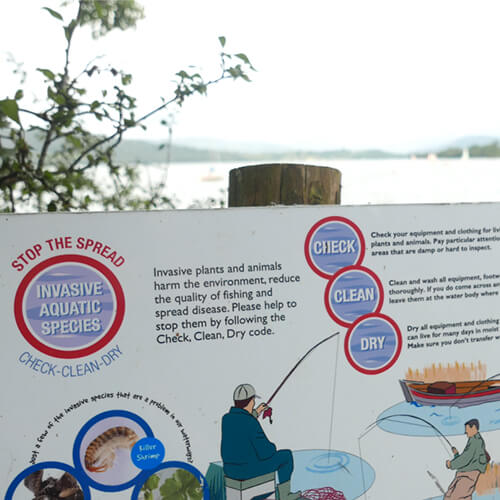
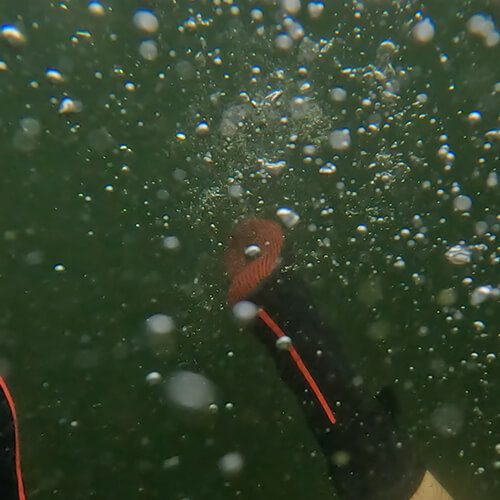
During my conversations with regular swimmers, there appears to be confusion and division forming, particularly by those who have not encountered ill health themselves or heard of concerns among peers.
Some concerned swimmers adapt their practice by switching to dips, keeping their head above the surface, avoiding swallowing the water, reassessing their entry and swim trajectory, and sometimes rushing back home to wash their bodies and swim kit afterwards.
Other regular swimmers suggest avoiding Windermere during the summer or swimming elsewhere in sight of blooms, slicks, or scums, moving their practice to other sites or further along the shoreline.
For others, it is business as usual, particularly those carrying heavy motivations to swim. There can also sometimes be unawareness, though some swimmers suggest there may be many users turning a blind eye.
Aside from regular full-body shivers, I have not experienced ill health from swimming at Rayrigg Meadow or Millerground, yet I do not dismiss the environmental health concerns at Windermere. Equally, I stress that swim safety needs to share the spotlight, communicating the risks of cold-water shock, hypothermia, and after-drop, alongside the uneven structural inequalities that can hinder swimming ability.
You can find more information about blue-green algae on the UK Centre for Ecology and Hydrology’s (UKCEH) website [15]. They also encourage using their ‘Bloomin Algae’ app [16], which is directly linked to and investigated by the Environment Agency (EA). The EA also recommends users to call their incident hotline (Call: 0800 807 060). The Outdoor Swimming Society [17] and Public Health England [18] have also produced guidance for bathers encountering blue-green algae.
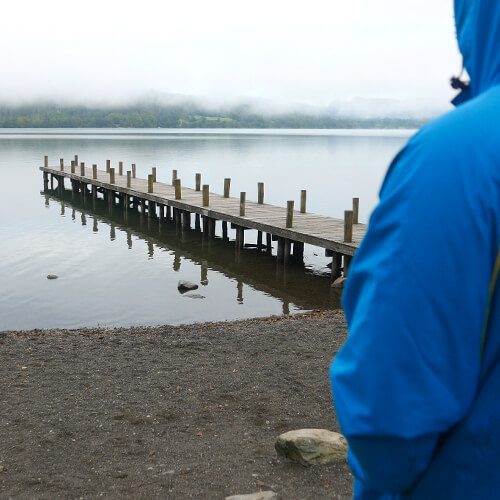
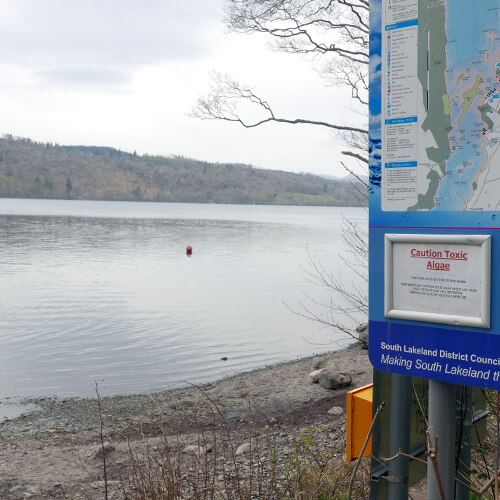
These senses of risk can become further complicated by the wildly varying approaches to communicating these environmental issues by local activists, freshwater ecologists, United Utilities (UU), and the regulators (EA).
Water quality at Windermere has been studied since 1929 by the Freshwater Biological Association (FBA) [19]. Studies at Windermere were later supported by the ‘Cumbrian Lakes Monitoring Platform’ in 1945, led since 1989 by the UKCEH [20], alongside the recent introduction of the ‘Big Windermere Survey’, led by the FBA and Lancaster Environment Centre since 2022 [21].
Stakeholder partnerships and continued regulation led by the EA has also formed over the past three decades. The EA recently unveiled its new ‘Love Windermere’ partnership. The partnership includes working with the Lake District National Park Authority, Freshwater Biological Association, Lake District Foundation, The National Trust, South Cumbria Rivers Trust, National Farmers Union, Westmorland and Furness Council, United Utilities, and the Cumbria Local Enterprise Partnership. Together this partnership aims to join forces using an ‘evidence-based approach’ to counter the complexities of Windermere’s social, economic, and environmental concerns [22].
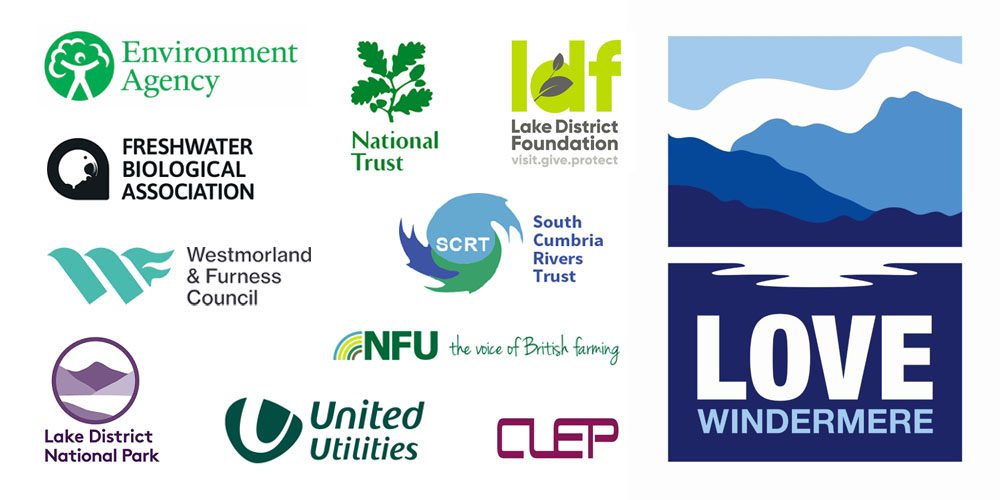
Doubts have been cast upon the regulation, partnerships, and the suggested complexities by the ‘Save Windermere’ campaign, led by local activist Matt Staniek, who calls for UU to simply ‘stop the sewage’ [23].
The Save Windermere campaign has predominantly focused on links around nutrient enrichment from treated and untreated sewage from UU wastewater treatment works and storm overflows. There are demands for UU to provide transparent monitoring, while ultimately calling for them to stop all sewage outputs into Windermere.
During my observations, the Save Windermere campaign has generated significantly broader public awareness, alongside further ambivalence, over the past two years through persistent and reactive online efforts, local events, posters, stickers, and alliance with the national press, media, and popular influencers/celebrities.
The campaign also aligns with increasing national public pressure on the responsibilities of private water companies and tighter government regulation. These demands include calling for more authoritative powers provided to the EA, noting the EA have been stripped back of funding since 2013 [24].
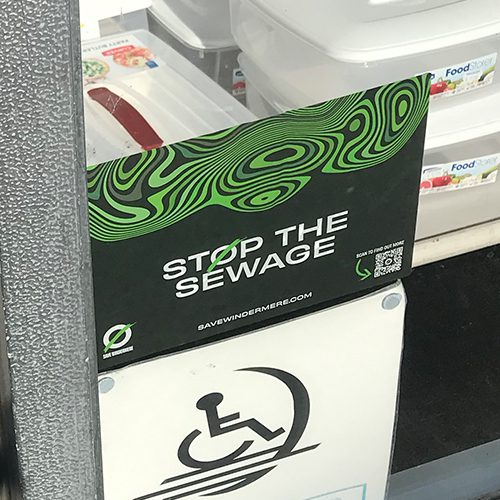
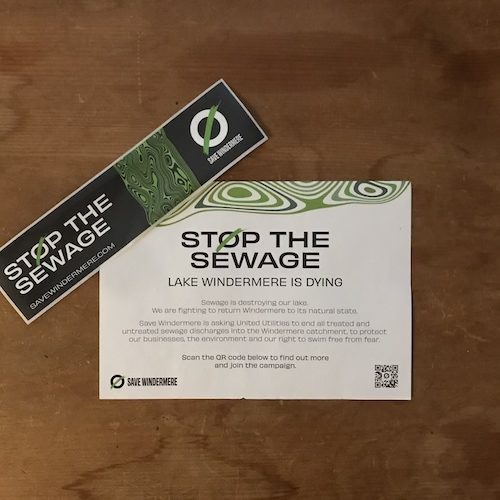
Another communication complication I have observed is the general unawareness of the existence, role, and status of ‘designated public bathing sites’. In England, the ‘official’ bathing season is recognised by DEFRA, the EU Bathing Water Directive, and the EA between 15th May – 30th September each year [25]. In England, there are over four hundred designated public bathing sites. However, most of these sites are coastal, with England featuring fewer than twenty designated public bathing sites within inland waters. Surprising to many swimmers I speak with, Windermere currently features four designated public bathing sites. These sites include:
- Millerground Landing (Eastern shore, North Basin, registered in 1998 – Profile)
- Rayrigg Meadow (Eastern Shore, North Basin, registered in 2015 – Profile)
- Fell Foot (Eastern shore, South Basin, registered in 1998 – Profile)
- Lakeside YMCA (Western Shore, South Basin, registered in 1998 – Profile)
Weekly water quality samples are taken by the EA between May – September each year at these designated public bathing sites and reported on their Swimfo website [26]. The EA tests for two potentially pathogenic bacteria indicators – Escherichia coli (E.coli) and Intestinal Enterococci, sometimes attributed to faecal matter contamination [27].
These two indicators are used in conjunction with the EU Bathing Water Directive’s classifications, marking these swim sites as Excellent, Good, Sufficient, Poor, or ‘Advice Against Bathing’ [28], yet cyanobacteria toxins are not systematically tested under this classification.
Following communication from the EA, the landowners at these sites are responsible for displaying public messaging regarding the water quality status [29], though I do question whether users acknowledge these signs.
Notably, these four designated sites on Windermere have been reported as ‘Excellent’ for the past seven years [30].
Swimmers aware of these designations sometimes align with these measures when assessing and communicating concerns within the swim communities, although I sense many swimmers are still unfamiliar.
It’s also important to note that many users continue to swim at sites on Windermere that are not designated.
Since diving deeper into the research, these ‘official’ water quality understandings still pose many questions. Not only concerning the clumsy phrasing of ‘Advice Against Bathing’. But, also, I query why there is no official bathing water testing by the EA outside of May – September. Of course, there is an economic justification required. Yet, outdoor swimming in the UK is now widely practised all year [31].
Plus, the weather is typically wetter in the winter. This raises questions about whether these increasingly popular designated public bathing sites, alongside other swim sites, are under further pressure during the winter seasons from agricultural and urban run-off, combined sewage overflows, wastewater treatment works, private septic tanks, and other wastewater misconnections [32].
The EU Bathing Waters Directive also universalise these bathing water testing measures for coastal and freshwater environments, neglecting the site-specific characteristics and challenges of different waters. While cyanobacteria toxins are not included in the classification, the EA do separately investigate and communicate reports of blue-green algae and other environmental incidents [33].
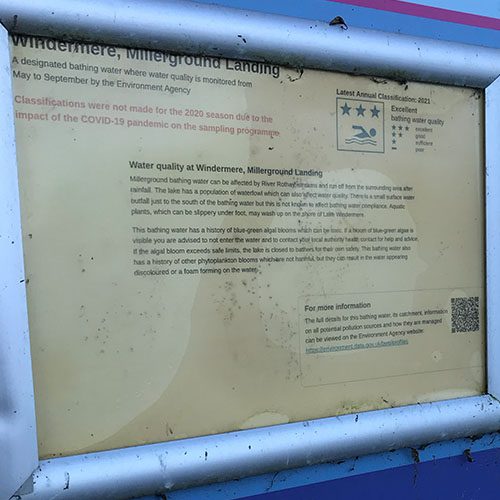
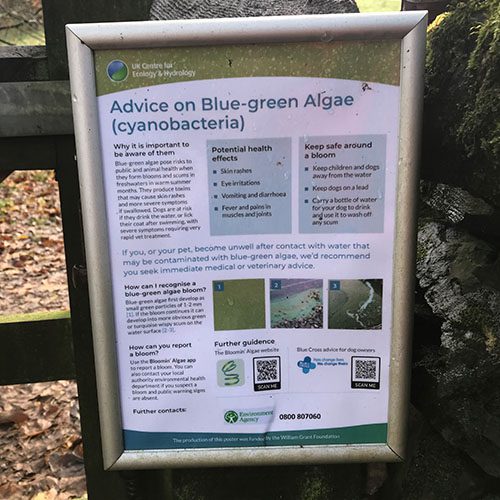
This understanding of water quality also puts human health concerns at the centre.
Fortunately, other water quality parameters are tested throughout the year at Windermere, including long-term monitoring by the UKCEH. Last year, the UKCEH [34] reported that Windermere’s annual water surface temperature has risen by 1.7°C over the past 70 years which can continue to favour the growth rate of cyanobacteria. The UKCEH [35] also suggested “dissolved phosphorus concentrations, affected by inputs from sewage, agricultural runoff, and potentially lake sediments have declined over the long term”, also reporting, “on average, changes in patterns of algal growth because of these influences, have been subtle”.
This report conflicts with the narrative of local activists and generates further ambivalence for invested users.
The UKCEH’s [36] Cumbrian Monitoring Platform test for:
- Physical conditions: water temperature, transparency, above-water meteorology.
- Chemical conditions: pH, alkalinity, concentrations of oxygen and nutrients (phosphorus, nitrogen and silica).
- Freshwater species: phyto- and zooplankton and fish populations.
The FBA, alongside Lancaster Environment Centre at Lancaster University, also lead a citizen science project known as the ‘Big Windermere Survey’. Since 2022, the Big Windermere Survey has completed four surveys, representing each season across the year [37].
The Big Windermere Survey facilitates samples: “from approximately 100 different locations on Windermere and in the rivers and lakes that flow into it. The samples are analysed for nutrient and bacterial concentrations at independent laboratories, producing the largest, one-day snapshot of conditions in Windermere” [38].
The FBA [39] also recognise that it’s early days, noting the “official classification of water quality against standards requires long-term data sets, comprised of multiple samples taken from each location to capture variation in water quality between seasons and years.”
Four individual survey summary reports and a breakdown of each survey’s findings are available on the FBA’s website [40]. Funding for the fifth survey has been established and an annual report is soon to be published.
Video: Freshwater Biological Association
Again, I recognise that some swimmers have aligned their assessments of health concerns at Windermere with these summary reports.
While I have tried to stay close to these reports, the more-than-human dimensions can, at times, be challenging to interpret as a humble swim researcher without prior knowledge of the biological breakdown of freshwater environments such as Windermere. I suspect other swimmers and dippers may feel the same. I also recognise that the Big Windermere Survey could be limited by the EU Bathing Water Directive’s classifications. But still, I continue to engage with their project and try to learn about the characteristics of Windermere.
I also support those questioning the responsibilities of UU, our government, and the regulators, but also acknowledge Windermere is complex and conflicted by other stakeholders and users.
The social and environmental pressures at Windermere are a moving target, requiring continual risk assessment when/if interacting with the water. Again, this blog is just a snippet of my reflections over the past ten months.
There may also be subjective and inequitable understandings when assessing our considerations for ‘healthy’ swimming practice, while the fogginess of ‘yet’ continues to sit uncomfortably within our changing climates.
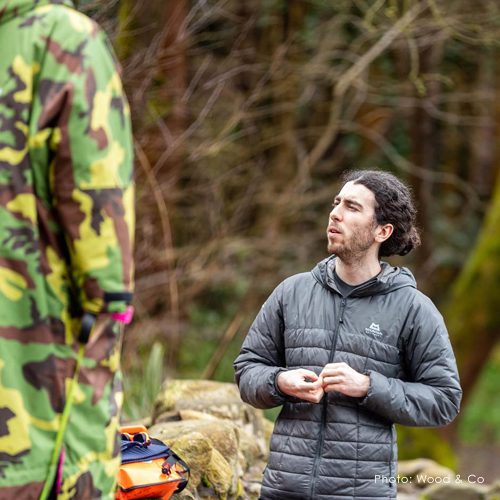
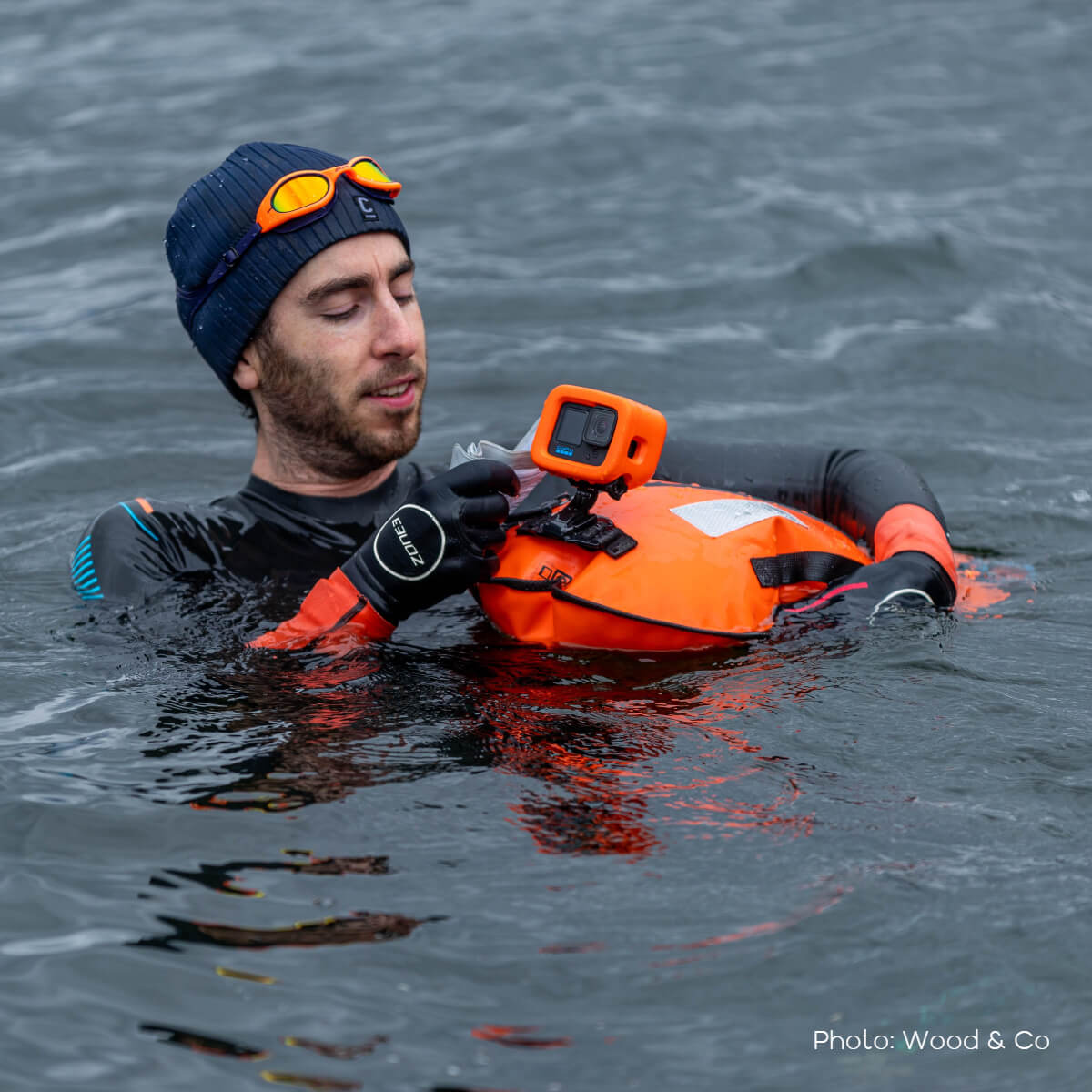
The fieldwork has been challenging and tense at times, particularly when my role and opinions as a researcher have been questioned, in and out of the water. While I may wear goggles and sport a frazzled mop of hair, I do not carry a white coat or an authoritative voice regarding the safety of swimming in Windermere.
By questioning the perceptions and assessments of risk, I see my role as trying to help swimmers and dippers reflect on their practices. I also intend to give back to current (and potential) swim communities with my reflections in my thesis and other research outputs, encouraging empathy and care within these fragile shared spaces.
These opportunities for output are still a long way off. Two months of the fieldwork remain at Rayrigg Meadow and Millerground, meaning many more observations and thoughts are still awaiting to be soaked up.
So, if you fancy taking part in a conversation on the shore or as part of a swim-along interview, please do get in touch.
References
[1] Thackery, S. (2022). Extensive algal blooms in England’s lakes: here’s why. [online] The Conversation (26 Aug). Available at: <www.theconversation.com/extensive-algal-blooms-in-englands-lakes-heres-why-189481> [Accessed: 19 Jul 2023].
[2] Freshwater Biological Association. (2023). Hot weather triggers algal blooms in Windermere. [online] (15 Jun). Available at: <www.fba.org.uk/fba-voice/esi4ijp3bmg9ua92gkk109vop2h7ln> [Accessed: 19 Jul 2023].
[3] McGowan, S,. Barker, P., Haworth, E.Y., Leavitt, P.R., Maberly, S.C., Pates, J. (2011). Humans and climate as drivers of algal community change in Windermere since 1850. Freshwater Biology, 57(2): 260–277.
[4] Rhodes, G., Porter, J. and Pickup, R.W. (2011). The bacteriology of Windermere and its catchment: Insights from 70 years of study. Freshwater Biology, 57(2): 305–320.
[5] Moorhouse, H.L., McGowan, S., Taranu, Z.E., Gregory-Eaves, I., Leavitt, P.R., Jones, M.D., Barker, P. and Brayshaw, A.B. (2018). Regional versus local drivers of water quality in the Windermere catchment, Lake District, United Kingdom: The dominant influence of wastewater pollution over the past 200 years. Global Change Biology, 24(9): 4009–4022.
[6] Surridge, B., Maberly, S., Thackery, S. and Johnson, S. (2022). Cyanobacterial blooms on Windermere: Statement by FBA. [online] Freshwater Biological Association (22 Aug). Available at: <www.fba.org.uk/fba-voice/cyanobacterial-blooms-on-windermere> [Accessed: 19 Jul 2023].
[7] Ibid.
[8] Ibid.
[9] UK GOV. (2019). Guidance: Swim Healthy. [online] (24 Jun). Available at: <www.gov.uk/government/publications/swim-healthy-leaflet/swim-healthy> [Accessed: 19 Jul 2023].
[10] McGowan, S., Adlam, C., Adolphs, S., Carvalho, L. and Moffatt, F. (2023). Are you swimming in fresh water?. The Freshwater Biological Newsletter, No.86 Winter, 2023/23: 12-15.
[11] Ibid.
[12] Environment Agency. (2022). Swimfo: Find a bathing water. [online]. Department for Environment, Food & Rural Affairs (DEFRA). Available at: <environment.data.gov.uk/bwq/profiles> [Accessed: 19 Jul 2023].
[13] Surridge, B., Maberly, S., Thackery, S. and Johnson, S. (2022). Cyanobacterial blooms on Windermere. [online] UK Centre for Ecology & Hydology (22 Aug). Available at <www.ceh.ac.uk/news-and-media/news/cyanobacterial-blooms-windermere> [Accessed: 19 Jul].
[14] GB Non-native Species Secretariat. (2023). Check Clean Dry. [online] Available at: <www.nonnativespecies.org/what-can-i-do/check-clean-dry> [Accessed: 19 Jul 2023].
[15] Ibid [13].
[16] UK Centre for Ecology & Hydrology. (2023). Blooming’ Algae. [online]. Available at <www.ceh.ac.uk/our-science/projects/bloomin-algae> [Accessed: 19 Jul 2023].
[17] The Outdoor Swimming Society. (2021). Understanding Algal Blooms. [online] (22 Mar). Available at: <www.outdoorswimmingsociety.com/swimming-safely-algal-blooms> [Accessed: 19 Jul 2023].
[18] Ibid [9].
[19] Maberly, S. And McGowan, S. (2022). The State of Windermere. Freshwater Biological Association InfoNote 1: February 2022. [online]. (1 Oct). Available at: <www.fba.org.uk/fba-voice/the-state-of-windermere-information-note> [Accessed: 19 Jul 2023].
[20] Ibid.
[21] Freshwater Biological Association. (2023). The Big Windermere Survey. [online]. Available at: <www.fba.org.uk/freshwater-citizen-science/the-big-windermere-survey> [Accessed: 19 Jul 2023].
[22] Love Windermere Partnership. (2023). About Us. [online]. Available at: <www.lovewindermere.co.uk/about-us> [Accessed: 19 Jul 2023].
[23] Save Windermere. (2023). Stop the Sewage. [online]. Available at: <www.savewindermere.com> [Accessed: 19 Jul 2023].
[24] Warden, K. (2013). Environment Agency cuts will have a far-reaching impact on communities. [online] The Guardian (16 Oct). Available at: <www.theguardian.com/public-leaders-network/2013/oct/16/environment-agency-cuts-spending-review-impact> [Accessed: 19 Jul 2023].
[25] Eaton, R. and Radford, I. (2023). Designated Bathing Waters Explained. [online] The Outdoor Swimming Society (10 Mar). Available at: <www.outdoorswimmingsociety.com/designated-bathing-waters-explained> [Accessed: 19 Jul 2023].
[26] Ibid [12].
[27] Ibid [10].
[28] Ibid [10].
[29] Department for Environment, Food & Rural Affairs (DEFRA) and Environment Agency. (2023). Bathing Waters. [online] UK GOV (10 Apr). Available at: <www.gov.uk/government/collections/bathing-waters> [Accessed: 19 Jul 2023].
[30] Ibid [12].
[31] Griffiths. S. (2023). Trends in Outdoor Swimming 2023. [online] (19 Feb) Outdoor Swimmer. Available at: <www.outdoorswimmer.com/extra/trends-in-outdoor-swimming-2023-2> [Accessed: 19 Jul 2023].
[32] Ibid [10].
[33] Environment Agency. (2023). Blue-Green Algae in Cumbria and Lancashire. [online]. Available at: <consult.environment-agency.gov.uk/cumbria-and-lancashire/blue-green-algae-in-cumbria-and-lancashire> [Accessed: 19 Jul].
[34] Ibid [6].
[35] Thackery, S. and Mackay, E. (2023). The state of lakes in the Windermere catchment – a long-term view. [online] UK Centre for Ecology & Hydrology (16 Jan). Available at: <www.ceh.ac.uk/news-and-media/blogs/state-lakes-windermere-catchment-long-term-view> [Accessed: 19 Jul 2023].
[36] Thackery, S. (2023). Cumbrian Lakes Monitoring Platform. [online]. UK Status, Change and Projections of the Environment (UK-SCAPE). Available at: <uk-scape.ceh.ac.uk/our-science/projects/cumbrian-lakes-monitoring-platform> [Accessed: 19 Jul 2023].
[37] Ibid [21].
[38] Ibid [22].
[39] Freshwater Biological Association. (2023). Big Windermere Survey: Water Quality Guide. [online]. Available at: <www.fba.org.uk/freshwater-citizen-science/the-big-windermere-survey> [Accessed: 19 Jul 2023].
[40] Ibid [21].
Author: Taylor Butler-Eldridge | Published: 19 July 2023
Blog
Keep up to date with the blog posts and updates from the research project.
